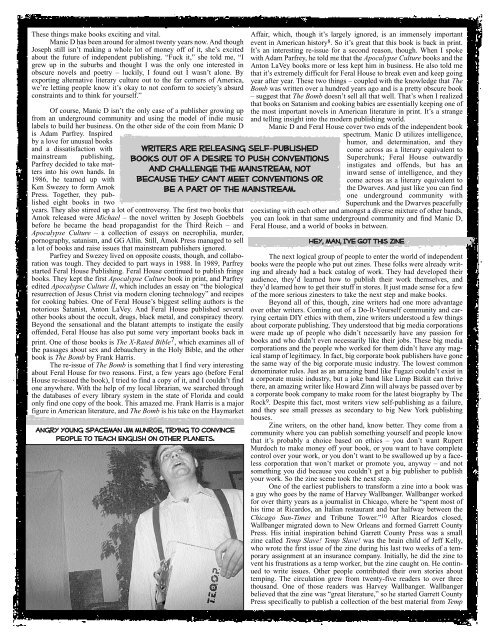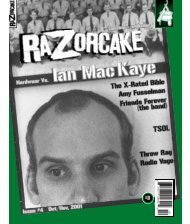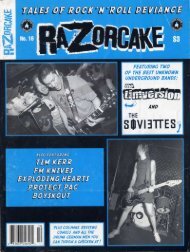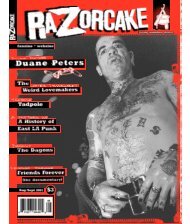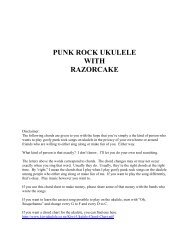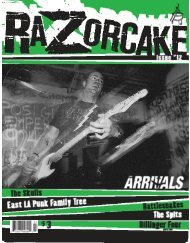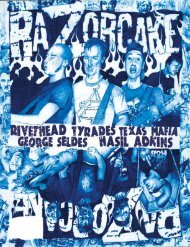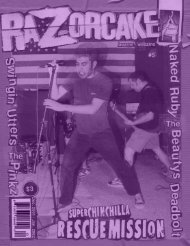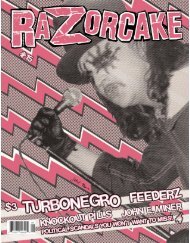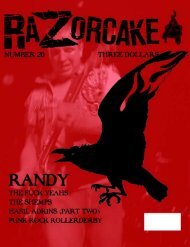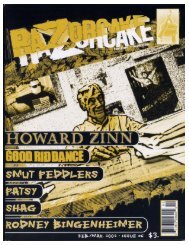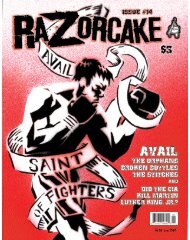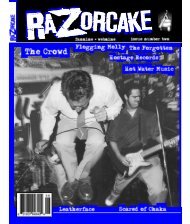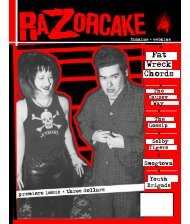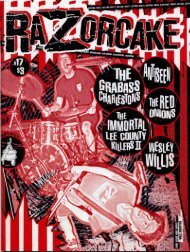(above) Indie press author rich mackin performing between bands.That’s bob tiltwheel cracking up in the back.unknown writer struggling to be heard. He’d been writing for years, andoccasionally, he’d get poems or short stories published in magazines andliterary journals. For the most part, though, no publisher would seriouslyinvest in Bukowski because he wrote about drinking too much and gamblingtoo much, about living his life in dive bars, about getting into fights,dating insane women, and being a bit insane himself. He was a voice forthe ignored and downtrodden people in our society. And Bukowski, himself,was ignored and downtrodden. Then, John Martin came along.Martin was a fan of Bukowski’s writing. He couldn’t understandwhy publishers wouldn’t touch Bukowski’s books, so Martin decided todo something about it. In 1966, Martin formed Black Sparrow Press.Black Sparrow was launched specifically to publish Bukowski’s work.Their first release was At Terror Street and Agony Way, a book ofBukowski’s poems. Between At Terror Street and Bukowski’s regularcolumn in Open City (a Los Angeles-based underground newspaper),Bukowski quickly developed a following. Readers loved Bukowski’s rawwriting style and his base subject matter. They loved reading about fighting,degenerates, abuse, and illness. Readers hadn’t seen anyone whowrote like Bukowski. They were reading his stuff for the first time, andthey loved it. And readers still love it today. Pick up any zine in anyrecord store, or walk into any creative writing class, and you’ll find atleast one person there who’s trying to write like Bukowski. Walk intopretty much any punk house or any slacker’s apartment and you’ll find atleast one book of Bukowski’s poems. Hell, even one of the biggest undergroundbands today, Hot Water Music, stole theirname from the title of a Bukowski book. But I’mgetting ahead of myself.At Terror Street created such a stir thatBlack Sparrow dedicated themselves to promotingthe writings of Charles Bukowski. Over the courseof the next thirty-four years, Black Sparrow wenton to publish more than thirty books byBukowski. The Bukowski books sold so well thatthey allowed Black Sparrow the financial freedomto publish whatever else they wanted. They took advantage of that freedomand established a tradition of publishing eclectic and risky titles bysome really cool authors like Diane Wakoski, Robert Creeley, and AndreiCodrescu. And over the last few years, Black Sparrow has taken advantageof that freedom by re-releasing the works of John Fante – the writerwho Bukowski cites as his biggest influence.Of course, City Lights and Black Sparrow weren’t the only independentpublishers born out of the fifties and sixties. They’re just two ofthe biggest and most successful independent publishers of their era.They’re also two publishers that established the model that so many contemporaryindependent presses follow now 3 .The Punks Get in the MixThe obstacles that writers like Allen Ginsberg and CharlesBukowski faced were pretty typical. Since the earliest days of the printingpress, there have been writers who want to push their art innew, risky, unconventional directions, and there have been publisherswho understand that printing books costs a lot of money, sothey’re only willing to print books that are similar to books thathave sold well in the past. This clash has existed as long as bookshave existed. Things got worse for writers in the eighties, though,when a few large corporations hijacked the book industry. Thesesame large corporations 4 were in the process of taking over all ofthe mass media: music, magazines, movies, television, newspapers,and books. With this conglomeration of the book industry, allhope of publishers nurturing writers and developing unique voicespretty much flew out the window. These companies were (andare) concerned solely with profit. The quality and originality ofthe books being released after these corporations took over thebook industry quickly degenerated 5 .Luckily, an answer to this problem already existed. When bigcorporations took over the music industry, musicians started theirown record labels, released their own music, and took a chunk ofthe music industry back. When big corporations took over themagazine industry, writers started their own magazines and zines,released their own work, and took a chunk of the magazine industryback. These indie labels, magazines, and zines created a supportsystem within themselves which allowed them all to exist onthe fringes of society. (Obviously, you know this; you’re readingone of those zines right now.) This support system also allowedindependent book publishers to surface out of the underground.Manic D Press was one of the first indie publishers to rise out ofthis underground. Manic D founder Jennifer Joseph wanted to get publishedand found that no publisher was interested in backing work by ayoung, unknown poet. So she decided to do it herself. Initially, she followedthe City Lights example, hanging out at City Lights Bookstore andstudying the design and layout of their books. She bought The Publish-It-Yourself Handbook by Bill Henderson, read it, figured out how to puther own book out, and, in 1984, she released the first Manic D title, TheFuture Isn’t What It Used To Be. Success wasn’t immediate for her like itwas for Ginsberg and Bukowski. She wasn’t able to find anyone to distributeher book, so she resorted to what she calls “the hoof-and-woofmethod of distribution.” Like any kid with a fanzine would do, Josephtook her books to local independent book stores and put them on consignment,checking back regularly to see if any sold. Beyond that, she didwhatever else she could to get the word out. Though The Future wasn’ta runaway success, Joseph was inspired to continue publishing. Shereleased several books and marketed them the same way indie recordlabels market their bands: she sent writers on national tours where they’dread their work in bars, clubs, bookstores, or wherever they could schedulea reading. She moved beyond the hoof-and-woof method and gotpicked up by Last Gasp Distribution and Small Press Distribution. Andthe do-it-yourself ethic worked for Joseph and the Manic D writers. Theywere able to putout books thatmainstream pub-As more good independent books getreleased, readers start to understandthat independence from big media corporationsis a choice, not a failurelishers weren’tinterested in, butreaders loved.They were able toestablish the foundationof an independentliterarycommunity. On asmall scale, it even started to pay off when, ten years after she startedManic D, Joseph signed a distribution deal with Publishers Group West.At that point, the company became profitable enough to be Joseph’s mainsource of income.Manic D may not be turning the literary world on its ass like theBeat Generation did, but they are “making the world safe for intelligentfreaks and poets with a sense of humor.” 6 Manic D consistently publishesgood books. They take risks that would scare most presses. They nurturetheir writers and allow their writers to expand and develop inunorthodox ways. And, though Manic D publishes a fairly diverse mixtureof books, there’s a definite sense of taste. If nothing else, when I seea Manic D book in a bookstore, I know that Jennifer Joseph recommendsthat book, and I know that she’s a pretty good judge of writing. That’soften a good enough reason for me to pick up a book. And it’s thesethings – taking risks, nurturing writers, developing a sense of taste – thatset an indie publisher apart from a big, corporate publisher.37
These things make books exciting and vital.Manic D has been around for almost twenty years now. And thoughJoseph still isn’t making a whole lot of money off of it, she’s excitedabout the future of independent publishing. “Fuck it,” she told me, “Igrew up in the suburbs and thought I was the only one interested inobscure novels and poetry – luckily, I found out I wasn’t alone. Byexporting alternative literary culture out to the far corners of America,we’re letting people know it’s okay to not conform to society’s absurdconstraints and to think for yourself.”Of course, Manic D isn’t the only case of a publisher growing upfrom an underground community and using the model of indie musiclabels to build her business. On the other side of the coin from Manic Dis Adam Parfrey. Inspiredby a love for unusual booksWriters are releasing self-publishedbooks out of a desire to push conventionsand challenge the mainstream, notbecause they can’t meet conventions orbe a part of the mainstream.and a dissatisfaction withmainstream publishing,Parfrey decided to take mattersinto his own hands. In1986, he teamed up withKen Swezey to form AmokPress. Together, they publishedeight books in twoyears. They also stirred up a lot of controversy. The first two books thatAmok released were Michael – the novel written by Joseph Goebbelsbefore he became the head propagandist for the Third Reich – andApocalypse Culture – a collection of essays on necrophilia, murder,pornography, satanism, and GG Allin. Still, Amok Press managed to sella lot of books and raise <strong>issue</strong>s that mainstream publishers ignored.Parfrey and Swezey lived on opposite coasts, though, and collaborationwas tough. They decided to part ways in 1988. In 1989, Parfreystarted Feral House Publishing. Feral House continued to publish fringebooks. They kept the first Apocalypse Culture book in print, and Parfreyedited Apocalypse Culture II, which includes an essay on “the biologicalresurrection of Jesus Christ via modern cloning technology” and recipesfor cooking babies. One of Feral House’s biggest selling authors is thenotorious Satanist, Anton LaVey. And Feral House published severalother books about the occult, drugs, black metal, and conspiracy theory.Beyond the sensational and the blatant attempts to instigate the easilyoffended, Feral House has also put some very important books back inprint. One of those books is The X-Rated Bible 7 , which examines all ofthe passages about sex and debauchery in the Holy Bible, and the otherbook is The Bomb by Frank Harris.The re-<strong>issue</strong> of The Bomb is something that I find very interestingabout Feral House for two reasons. First, a few years ago (before FeralHouse re-<strong>issue</strong>d the book), I tried to find a copy of it, and I couldn’t findone anywhere. With the help of my local librarian, we searched throughthe databases of every library system in the state of Florida and couldonly find one copy of the book. This amazed me. Frank Harris is a majorfigure in American literature, and The Bomb is his take on the Haymarketangry young spaceman jim munroe, trying to convincepeople to teach English on other planets.Affair, which, though it’s largely ignored, is an immensely importantevent in American history 8 . So it’s great that this book is back in print.It’s an interesting re-<strong>issue</strong> for a second reason, though. When I spokewith Adam Parfrey, he told me that the Apocalypse Culture books and theAnton LaVey books more or less kept him in business. He also told methat it’s extremely difficult for Feral House to break even and keep goingyear after year. These two things – coupled with the knowledge that TheBomb was written over a hundred years ago and is a pretty obscure book– suggest that The Bomb doesn’t sell all that well. That’s when I realizedthat books on Satanism and cooking babies are essentially keeping one ofthe most important novels in American literature in print. It’s a strangeand telling insight into the modern publishing world.Manic D and Feral House cover two ends of the independent bookspectrum. Manic D utilizes intelligence,humor, and determination, and theycome across as a literary equivalent toSuperchunk; Feral House outwardlyinstigates and offends, but has aninward sense of intelligence, and theycome across as a literary equivalent tothe Dwarves. And just like you can findone underground community withSuperchunk and the Dwarves peacefullycoexisting with each other and amongst a diverse mixture of other bands,you can look in that same underground community and find Manic D,Feral House, and a world of books in between.Hey, Man, I’ve Got This ZineThe next logical group of people to enter the world of independentbooks were the people who put out zines. These folks were already writingand already had a back catalog of work. They had developed theiraudience, they’d learned how to publish their work themselves, andthey’d learned how to get their stuff in stores. It just made sense for a fewof the more serious zinesters to take the next step and make books.Beyond all of this, though, zine writers had one more advantageover other writers. Coming out of a Do-It-Yourself community and carryingcertain DIY ethics with them, zine writers understood a few thingsabout corporate publishing. They understood that big media corporationswere made up of people who didn’t necessarily have any passion forbooks and who didn’t even necessarily like their jobs. These big mediacorporations and the people who worked for them didn’t have any magicalstamp of legitimacy. In fact, big corporate book publishers have gonethe same way of the big corporate music industry. The lowest commondenominator rules. Just as an amazing band like Fugazi couldn’t exist ina corporate music industry, but a joke band like Limp Bizkit can thrivethere, an amazing writer like Howard Zinn will always be passed over bya corporate book company to make room for the latest biography by TheRock 9 . Despite this fact, most writers view self-publishing as a failure,and they see small presses as secondary to big New York publishinghouses.Zine writers, on the other hand, know better. They come from acommunity where you can publish something yourself and people knowthat it’s probably a choice based on ethics – you don’t want RupertMurdoch to make money off your book, or you want to have completecontrol over your work, or you don’t want to be swallowed up by a facelesscorporation that won’t market or promote you, anyway – and notsomething you did because you couldn’t get a big publisher to publishyour work. So the zine scene took the next step.One of the earliest publishers to transform a zine into a book wasa guy who goes by the name of Harvey Wallbanger. Wallbanger workedfor over thirty years as a journalist in Chicago, where he “spent most ofhis time at Ricardos, an Italian restaurant and bar halfway between theChicago Sun-Times and Tribune Tower.” 10 After Ricardos closed,Wallbanger migrated down to New Orleans and formed Garrett CountyPress. His initial inspiration behind Garrett County Press was a smallzine called Temp Slave! Temp Slave! was the brain child of Jeff Kelly,who wrote the first <strong>issue</strong> of the zine during his last two weeks of a temporaryassignment at an insurance company. Initially, he did the zine tovent his frustrations as a temp worker, but the zine caught on. He continuedto write <strong>issue</strong>s. Other people contributed their own stories abouttemping. The circulation grew from twenty-five readers to over threethousand. One of those readers was Harvey Wallbanger. Wallbangerbelieved that the zine was “great literature,” so he started Garrett CountyPress specifically to publish a collection of the best material from Temp
- Page 2 and 3: When Sean and I started the print v
- Page 4 and 5: ,I’m Against It…tensions betwee
- Page 6: from the wads in the music ormotion
- Page 9 and 10: ered in lab tests that if the Pinto
- Page 11 and 12: the war, Schmidt was re-hired by Fo
- Page 13 and 14: Pog Mo ThonThe Discovery of America
- Page 15 and 16: A Distressing SceneThey looked for
- Page 17 and 18: MaddyShiftless When IdleMaddyFurthe
- Page 19 and 20: The Twisted BalloonShould the guy w
- Page 21 and 22: The reason God gave us hair is to g
- Page 23 and 24: know. I’ve hardly ever worn it an
- Page 25 and 26: this dinghole till it ripped, and h
- Page 27 and 28: 60 freeway, right across thestreet
- Page 29 and 30: Rikk: So in some ways, I guess that
- Page 31 and 32: things had turned around, at the fi
- Page 33: Weeds fromtheUndergroundA Closer lo
- Page 37 and 38: (he’ll release his next novel, Ev
- Page 39 and 40: plaints against each band member an
- Page 41 and 42: Sean: What’s wrong with mainstrea
- Page 43 and 44: multi-millionaire, and he paid me e
- Page 45 and 46: some intelligent things to say, but
- Page 47 and 48: WE’LL TAKEPENNYROLLS:Behind the S
- Page 49 and 50: KXLU VOLUNTEER MASSA HELPING OUTmak
- Page 51 and 52: KXLU DJ ANDY SALDANAtoo, by that ti
- Page 53 and 54: just picked it up by the end of the
- Page 55 and 56: like, “Shut up” and rolling the
- Page 57 and 58: ands spanning all these genres - em
- Page 59 and 60: Todd C: What sucks about that…Cas
- Page 61 and 62: I thought we hit something like ano
- Page 63 and 64: 440s / CHICKENHAWKS,The: Sumthin’
- Page 65 and 66: lessly pummeled my brains to apulp
- Page 67 and 68: air to the style, despite the poprh
- Page 69 and 70: ut delivered with the urgency ofear
- Page 71 and 72: collection. If this were a cereal,
- Page 73 and 74: of the sense that all is not well w
- Page 75 and 76: • 13th Street Entertainment, 338
- Page 77 and 78: one of their friends raping a girlb
- Page 79: Guilty PleasuresM. Christian, ed.,


